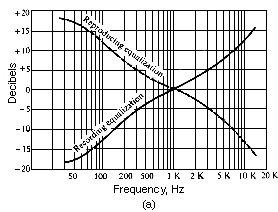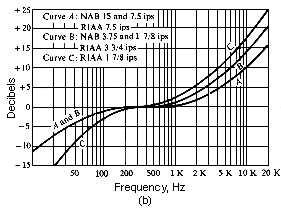The standard correction which is made during disc and tape recording or playback with regard to the FREQUENCY characteristics of the sound SIGNAL. This correction emphasizes some frequency BANDs in the SPECTRUM of a sound and de-emphasizes others. The process is also called compensation.
Equalization according to standard curves as shown below establishes the FREQUENCY RESPONSE characteristics for recording and playback of phonograph discs and magnetic tape. The recording characteristic is always the inverse of that of the playback; for example, high frequencies are boosted during disc recording by the same amount that they are attenuated during playback, thus resulting in FLAT response for the entire operation. 0 dB is set as the output at 1 kHz.
The curves for phonograph recording and playback, adopted in the U.S. and Great Britain in 1953, are known as the RIAA curves of standard equalization. The NAB and RIAA curves for tape recording (which operate in the opposite sense of those for disc with respect to frequency) are also shown. These characteristics are those of the pre-amplifier in most TAPE RECORDERs.
Besides standard equalization, other devices called equalizers, which are often built into mixers, are designed to perform a similar function on different parts of the audio spectrum. Those that are termed active can boost or attenuate (by ± 6 - 12 dB) bands, such as that around 10 kHz (to attenuate HISS or emphasize high frequencies), in the 2 - 4 kHz range (to improve PRESENCE) or those around 100 Hz (to control low frequencies or RUMBLE). The shelving type equalizer boosts or attenuates all frequencies above a specific high frequency, or below a specific low frequency.
Although some equalizers resemble FILTER banks, they differ in that only a limited range of AMPLIFICATION or ATTENUATION is possible. Equalizers are often identified by their CENTRE FREQUENCY (see chart under SOUND ANALYSER) and BANDWIDTH, such as 1/3 - octave, 1/2 - octave, full octave, and so on.
Controls marked TREBLE and BASS on amplifiers perform a similar function, but are more properly termed tone controls because they can only attenuate low or high frequencies respectively while boosting the entire signal level.


Effect of equalization networks on audio-amplifier frequency response: (a) standard RIAA recording and playback characteristics for phonograph records; (b) standard playback equalization characteristics for tape recorders (from Herrick, Instruments and Measurement for Electronics, McGraw-Hill, 1972, used by permission).
home